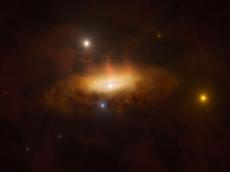|
|
TODAY.AZ / World news
Scientists record roar of supermassive black hole
20 June 2024 [21:22] - TODAY.AZ

By Alimat Aliyeva
At the center of the Milky Way galaxy is a supermassive black hole called Sagittarius A*, whose mass is four million times the mass of the Sun, and some astronomers call it a soft giant because of its silence. But one day he may become extremely active, Azernews reports.
According to the researchers, they observed in real time an amazing brightness caused by the awakening of a supermassive black hole in the center of another galaxy from a state of rest and the beginning of rotation along with nearby material. The roar of a black hole was also recorded at this time.
Ground-based and orbiting telescopes were used to observe events in the core of the galaxy SDSS1335+0728, located about 360 million light-years away in the constellation Virgo. A light—year is the distance that light travels in one year (9.5 trillion kilometers).
Black holes are extremely dense objects, and their gravity is so strong that even light cannot escape the attraction of these giants. Their sizes range from a mass equivalent to one star to monsters existing in the centers of many galaxies, millions or even billions of times larger than celestial bodies. The mass of the supermassive black hole in the galaxy SDSS1335+0728 is about a million times the mass of the Sun.
The environment around a supermassive black hole can be unusually "creepy" as it tears apart stars and absorbs any other material within its gravitational pull. The researchers reported that a rotating disk of diffuse material had formed around the supermassive black hole SDSS1335+0728, and that some of the matter had been depleted. This is called an accretion disk and emits energy at very high temperatures, sometimes exceeding the temperature of the entire galaxy.
Such a bright and compact region, powered by a supermassive black hole in the center of the galaxy, is called the "active galactic core." According to astrophysicist Paula Sanchez Saes of the European Southern Observatory in Germany, these nuclei emit large amounts of energy at wavelengths from radio to gamma rays. He added that such nuclei are considered to be among the brightest objects in the universe. The study of active galactic nuclei is crucial for understanding the evolution of galaxies and the physics of supermassive black holes.
Astronomers believe that the black hole in question is located far enough from Earth and does not pose a threat to our planet.
URL: http://www.today.az/news/regions/249781.html
 Print version
Print version
Connect with us. Get latest news and updates.
See Also
- 15 January 2026 [23:27]
Dodge drops Hornet crossover amid weak sales - 15 January 2026 [22:26]
Amazon rolls out cloud service for European data sovereignty - 15 January 2026 [21:45]
Finland bans social media for under-15s - 15 January 2026 [21:23]
Baykar targets 25–30 P180 aircraft per year after Piaggio acquisition - 15 January 2026 [20:22]
London, Ankara signal deeper trade and defence cooperation - 15 January 2026 [19:21]
Minister Uralo?lu outlines 2025 achievements, 2026 infrastructure goals - 15 January 2026 [15:12]
Trump imposes 25% tariff on high-end semiconductor chips - 15 January 2026 [14:19]
US President Trump says Ukraine, not Russia, is delaying peace deal - 15 January 2026 [12:59]
NATO allies deploy troops to Greenland as Trump’s annexation threats strain alliance - 15 January 2026 [12:24]
Trump expresses caution on Iran’s Reza Pahlavi as potential leader
Most Popular
 Azerbaijan launches industrial copper mining: Demirli opens up new opportunities
Azerbaijan launches industrial copper mining: Demirli opens up new opportunities
 Defense Ministry, Military Prosecutor sign plan to prevent violations in armed forces
Defense Ministry, Military Prosecutor sign plan to prevent violations in armed forces
 President Ilham Aliyev inspects reconstruction progress in Heyvali village, Aghdara district
President Ilham Aliyev inspects reconstruction progress in Heyvali village, Aghdara district
 Trade is changing logic of Azerbaijan-Armenia relations: market before and after
Trade is changing logic of Azerbaijan-Armenia relations: market before and after
 Armenia publishes framework for TRIPP transit route
Armenia publishes framework for TRIPP transit route
 Tehran warns of strikes on US bases across region
Tehran warns of strikes on US bases across region
 Protocol signed following 6th meeting of Azerbaijan-Italy Intergovernmental Commission
Protocol signed following 6th meeting of Azerbaijan-Italy Intergovernmental Commission
